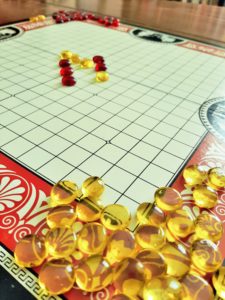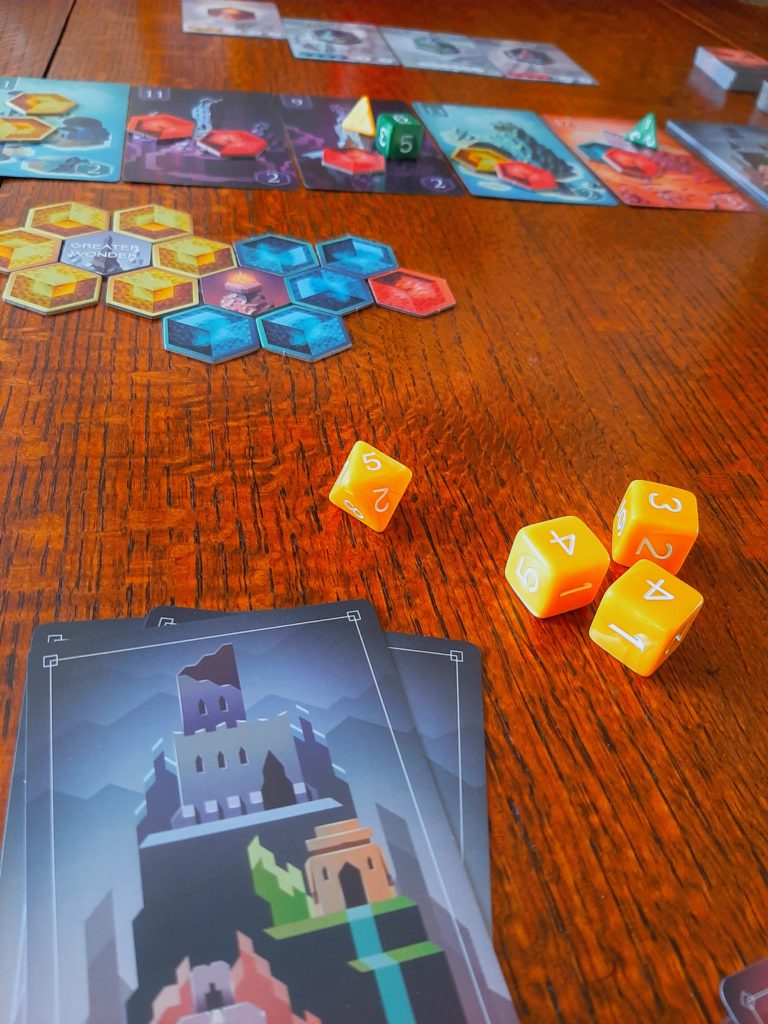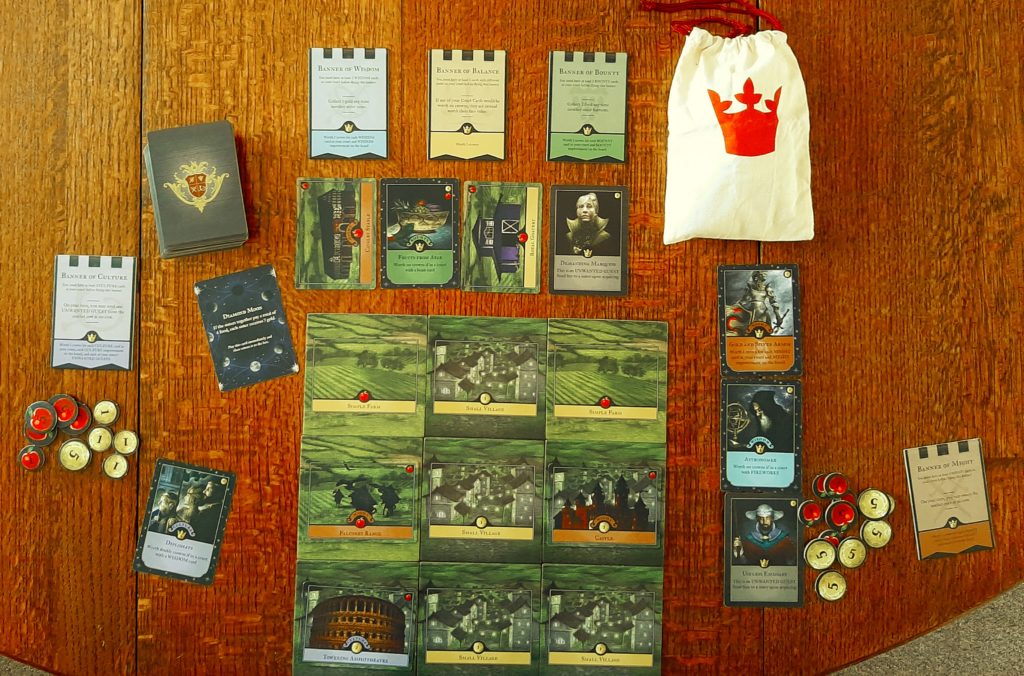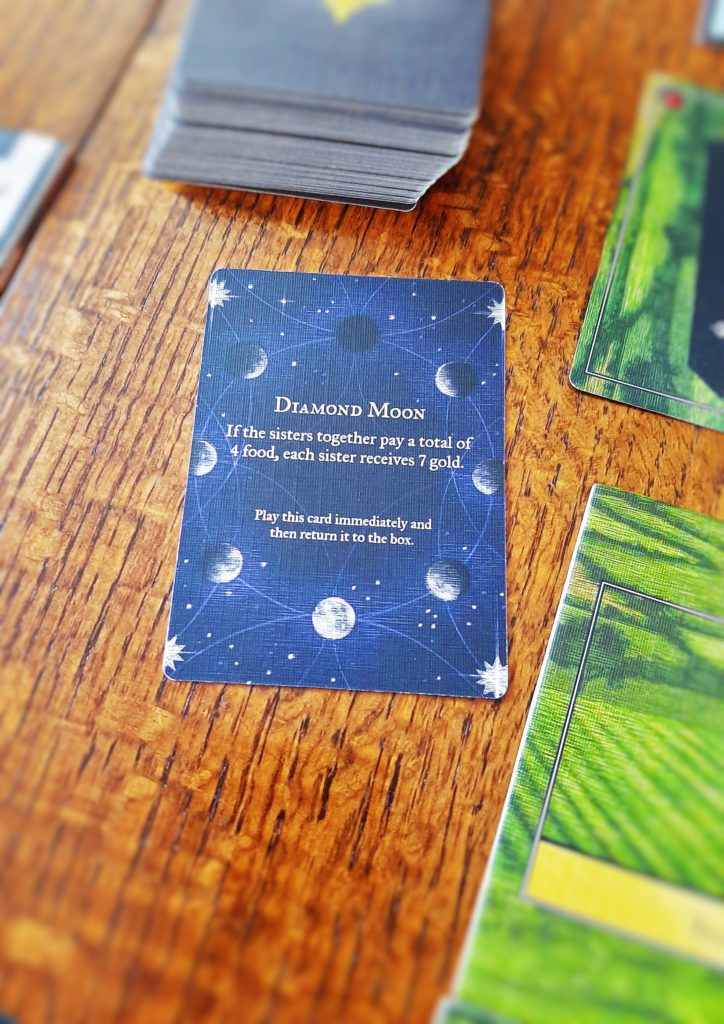I’m no Will Wheaton (who, aside from being a famous actor and Mental Health campaigner, also hosts the popular YouTube show “Tabletop”, on the Geek and Sundry channel) despite my childhood wish to be – well, what self-respecting nerdy lass wouldn’t want to grow up on the Starship Enterprise?! However, I do share his passion for board games (and on occasion, I share his appallingly bad mojo when it comes to dice rolls).
Tabletop gaming figured rather prominently in my childhood—immersing myself in dungeon-crawler games like Sorcerer’s Cave, questing as a knight in the Mystic Wood and epic journeying through different realms to finally obtain the Crown of Command in Talisman. This was the stuff of epic summer days with friends and siblings. We would be engrossed by campaign after campaign for hours, competing against monsters and challenges, finding untold treasures, and competing against each other to reign victorious..
Board games will forever be close to my heart for another important reason aside from childhood nostalgia: the first time my fiancé and I met, was at a geeky MeetUp group (called Geek Lite – for those people who really like Star Trek but don’t actually own a uniform), and our first ever conversation was about (you’ve guessed it…) board games! I think I won his admiration that day with my old-school gaming cred—he was particularly impressed by my having a first-edition copy of Talisman (the same one I played as a kid), and by my Dad being a Dungeon Master from the early days of D&D when I was still a toddler. As you can probably imagine, our combined games collection would take probably the best part of a week to get through!
So while many of us are hunkered down for the foreseeable, solo entertainment and old-school interactions with people we’re quarantined with are definitely de rigueur. Add board games to the list of must-do activities, along with sourdough baking, “pub” quizzes on Zoom, and Dalgona coffee! Being mindful that my all-time favorite games may not hold quite the same degree of charm and allure to those new to board gaming, I’ve come up with a selection of 5 approachable games, which span the range between 1-player to 4+ players; from intuitive and quick to learn, through to rather more involved, and from super-short to medium length. Re-playability is something I always consider (I’m not including games which lose their sparkle after one play), as well as artwork (there are some breathtakingly beautifully rendered games out there), and extra points go to games which have a cool or inventive game mechanic, as well as those which are easily played by people with different levels of color perception.
(In case you’re wondering, Pandemic does NOT feature in this list—mainly because it would just be way too close to home—am I right?)
So fasten your seat belts, whilst I take you on a whistle-stop tour of awesomeness! I guarantee that you’ll never get board with these games in your life (sorry – I can never, ever, resist a bad pun!)!!
5 Must-Play Board Games Under Lockdown

The classic edition
Number 5: Ticket to Ride
(basically, any edition is good, but this is the original USA version): by Alan R Moon, published by Days of Wonder
30–60 minutes, 2-5 players
A classic of our times, easy to learn, with a good number of extra editions. Ticket to Ride is super simple to learn, and stays interesting with its mix of strategy and chance at play. It’s not for nothing that this beauty was awarded “Spiel des Jahres” (German Game of the Year) in 2004.
The aim of the game is to get the most points. This is done both in-game, by building various railroad routes, and in post-play scoring (once one player has used all their allotted trains), for completed routes on your Ticket cards. The mechanic is pretty straightforward: pick train or Ticket card(s), or lay a route (using cute little plastic trains) between 2 towns, once you’ve collected enough of the relevant train cards. Depending upon how many players are involved, and how decisive they are in gameplay, games can last from around 30-60 minutes upwards. Since all players have different (hidden) objectives, the in-game competitiveness doesn’t tend to get too cut-throat (so little inherent chance of someone having a Monopoly tantrum)! Replayability is good too, with such a large array of routes up for grabs you’re unlikely to pick the same ones two games in a row.
Top tip: check that you’ve enough little plastic trains when selecting your routes, as you don’t want to run out midway through that last route… any Tickets you don’t complete will lose you points!
Accessibility: each different color of card has a cute little symbol which also appears on the card. Nifty solution, eh?!

Just too cute for words!
Number 4: Spirits of the Forest
by Michael Schacht (Game Designer) / Natalie Dombois (Artwork), Published by ThunderGryph Games
20–30 mins, 1–4 players
Not only is this a winning combination of arty nature-themed design work, but it comes with cute little sparkly gemstones (I can never resist a game that involves cute sparkly things)!! Gameplay is relatively simple—the beautifully rendered 48 tiles are laid out in 4 rows of 12 to form the “forest,” with additional “favour tokens” placed upside down on top of some, in a set pattern. These tokens are super useful, either to your points total at the end of the game, or to allow you certain special actions during gameplay.
Players take it in turns to collect tiles from either of the two “ends of the forest” (both the end tiles of each row), with 1 or a maximum of 2 matching “spirit” symbols. There’s then the chance to reserve any tile in the forest, by placing one of your sparklies on it, or by knocking off someone else’s gemstone and placing your own there instead.
Once all the tiles have been collected from the forest, the game is over, and scoring begins. Players compare the total number of each of the symbols they have collected, and gain points for any symbol group they have the highest number of, with deductions for any groups they’re missing.
I love the pretty, simple, lovely nature vibe, and the fact that it’s such a quick game to play, and really replayable! There’s even a slightly different game mechanic for the solo player variant, which keeps things challenging and interesting.
Accessibility: this is another thoughtfully-designed game, which uses pictures as well as colors to represent the type of nature spirits—so no accessibility issues here whatsoever!

Alluringly addictive
Number 3: Pente
by Gary Gabrel, published by Parker Bros
5–20 minutes, 2 players or 2 teams
Caution: this game is dangerously easy to learn, and seriously addictive. Once you start playing, its capacity for elegant strategic play, multiple-moves-ahead-logic, and the satisfying traps you can lay for your opponent will absolutely get its hooks into you! Think you can resist? Not a chance! You have been warned…
Developed in the 1970s by combining the games “Go,” “Niniku Rinju” and “Go-Moku,” the original board game of Pente has enjoyed multiple editions, a versus-computer version, an online versus-people version, and apparently there’s now a Pente Apple app available!
The premise is this: A grid, two players, each with a set of coloured stones. Player 1 must place their first stone into the centre of the grid. Each turn is one player putting one stone onto the board. You win the game with a line of 5 stones, or by capturing 5 pairs of your opponents’ stones (by surrounding them with two of your own).
To be honest, you don’t even need the board, the tech versions or the stones—you could make a board using graph paper, and use counters from another game. All you really need are the rules. Having said, the board is pleasingly elegantly designed, and the smooth, brightly colored glass stones are nicely tactile. They also do look very like little boiled sweets, so it’s the total package on the aesthetics front. Sadly as this was designed in the 1980s, accessibility was not a consideration for this game, but the stones could easily be substituted with counters from another game, to make it more inclusive.

Post-Apocalyptic archaeology, done in style!
Number 2: Unearth
Jason Harner and Matthew Ransom, published by Brotherwise Games
2–4 players, 20–30 minutes
The Backstory
“Long ago, your ancestors built great cities across the world. Now your tribe of Delvers must explore forests, deserts, islands, caverns, and mountains to find these lost cities. Claim the ruins, build places of power, and restore the glory of a bygone age…”(https://www.brotherwisegames.com/unearth)
A slightly more involved rulebook for this one: it’s the sort of game which for me, needed an initial play-through, to get to grips with the strategic aspects. However, if you want a head start, there is a YouTube Geek and Sundry Channel “Game the Game “ video on this—and I find Geek and Sundry videos to be pretty useful in making new games more approachable.
In a nutshell though, here’s my (hopefully) easy to follow précis:
- You have various types of dice (a different color per player), which you use to either gain “stones” from the main cards, on display, or to put towards gaining the “ruin” cards
- There are also “delver” cards which you get to play before using your dice, and these give you special bonuses or options.
- The colored stones you accumulate are hexagonal tiles, with which everyone builds their own grid formation with spaces in the center, for “wonders,” “great wonders” (in a space surrounded by stones of the same color) or special named wonders (requirements vary, depending on the named wonder in question). Wonders get you points at the end, great wonders get you more points, and named wonders get you cool stuff like special bonus actions/rewards during gameplay or a multiplier for a particular color at the end of the game.
- Basically, it’s a balance between acquiring stones to bag yourself as many wonders as you can, and building your collection of Ruins. Ruin cards come in different colors, and depending on how many of each/what sort of balance you get, will determine a large chunk of your points at the end. But Ruin cards are very limited, and once they’re gone, it’s game over—literally. So working on your stones/wonders collections can be a good way to extend gameplay, and gain lots more points. But just because you’re prioritizing stones, that doesn’t mean your opponent will be.
I find that Unearth has quite a bit of replayability, due to the number of different named wonders, the different approaches which are open to you, which give scope to drastically change the flow and feel of the game, and the element of chance and probability which the various dice bring.
This is another game featuring cool, atmospheric artwork, with a very post-apocalyptic-meets modernism vibe to it. Also, I’m a sucker for 4-sided and 8-sided dice.

The awesome, striking and refreshingly different “Monarch”
Number 1: Monarch
by Mary Flanagan, artwork by Kate Adams, published by Resonym
45 minutes, 3–4 players (n.b. I find 2-player games work just fine too)
Ta-dah! The numero uno super-duper fabuloso prize of awesomeness goes to this splendiferous creation, by Mary Flanagan and Kate Adams, who launched it on Kickstarter, and released it in 2015.
The backstory
Her Majesty the Queen is trying to decide which of her daughters is up to the job of ruling the kingdom of Minervia. So the Princesses (aka you and your fellow players) are in competition for the crown, on the basis of your chosen leadership “paths”: Bounty, Culture, Might, Wisdom, and Balance.
There are various court cards up for grabs in the “market” deck, which can be bought with food/gold. There is a “board” representing the kingdom and its resources (a 3×3 grid) which can be modified during the game, for the benefit of one/more of the sisters (and the inhabitants), and there are advisors, symbolic clothing, unwanted guests (which are given to the sister of your choice upon purchase) and more to collect, all of which add or deduct from your total score at the end. There are also “moon” cards, which allow for all the princesses to work together for the gain of all, but only if they all agree to co-operate.
The sister with the most Crown symbols on her court cards wins the throne. Once any player gains the maximum of 7 court cards, that becomes the last round, and all players must tally up their points at the end of the round, to find out who will be crowned the new Queen.

A “Moon Card” – bringing the option of collaboration with your opponents
I love so much about this game! It has beautiful, inventive artwork (I could just look at the cards all day!), which always entices me. But the fact that this was designed and created by two women, who self-published, and the fact that THE key theme is female power, puts a big smile on my face every time I play!
This is even carried forward into the gameplay itself: the rules and mechanics used, have a uniquely female quality, which sets it apart from pretty much every other boardgame I’ve ever played—and my gosh it works well! It has a competitive yet socially-focused style of play: players can take actions in any order they choose during their turns which (aside from being a nice regal touch) bucks the trend of the more “traditional,” often needlessly clunkily structured, rules-heavy, directive rules and gameplay which have been quite prevalent in the predominantly male-orientated boardgames industry. Monarch comes as such a breath of fresh air! It’s empowering and instead of trying to win over the rules-lawyer-type veterans, it simply provides for a more modern, socially empowered feminist player (male and female alike). Basically this game flies the flag for female gamers (and female geeks) in what has traditionally been quite a sexist interest group. It shows how liberating and enjoyable an empowering, strongly female-orientated game can be! The fact that the welfare and prosperity of the kingdom is always at the heart of the competition, and that there is a mechanic built-in to give opportunities for diplomacy and teamwork between the players, makes this feel a very grown-up and refreshingly well thought-out game.
Hurrah for women Leaders! Hurrah for women game-changing Game-makers! Long live the Monarch!!
Accessibility: As you might have guessed, accessibility has been thoughtfully provided for, as all of the info provided by color coding is also stated in text on the cards themselves.
Have you been playing any boardgames during the lockdown? Do you have any favourites not on this list that you’d like to share?Please do, as I’m always on the lookout for new games for the collection! Have you been playing any boardgames or RPGs online lately? And fellow Tabletop fan Dumplings, what’s the first boardgame that caught your imagination or got you hooked?
Also by Ema: Incredible Authentic Split Pea Dhal (Customizable)
What We Can Learn From The Orkney Islands About Well-Being While Social Distancing
Get more like this—Sign up for our daily inspirational newsletter for exclusive content!
__
Photo: Ema Melanaphy




